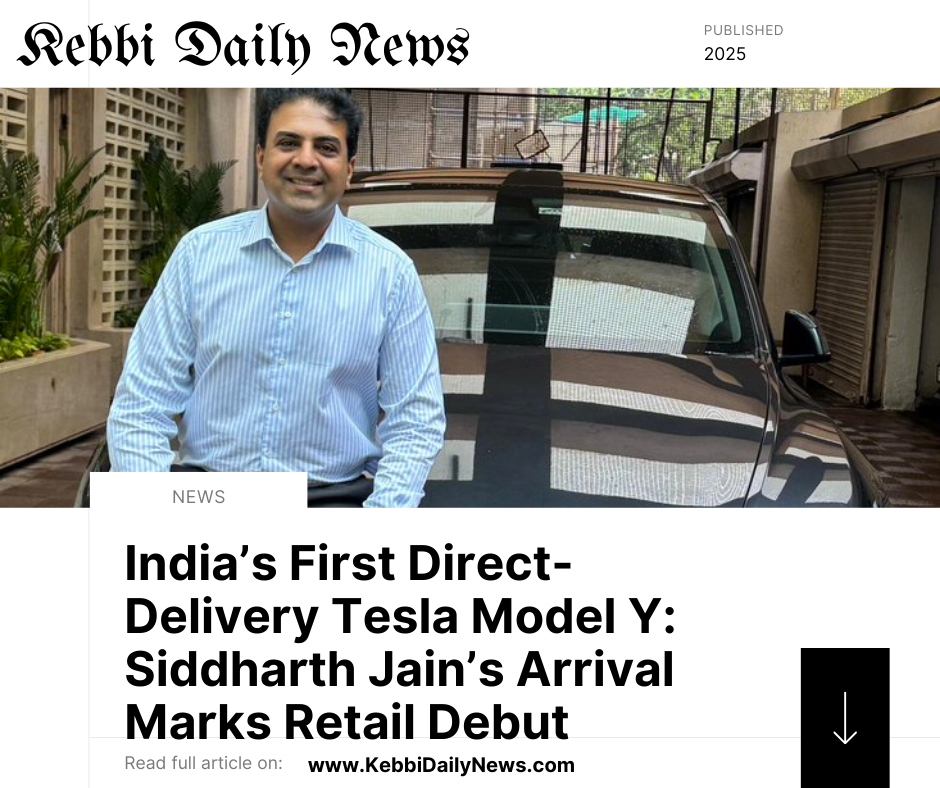
India’s First Direct-Delivery Tesla Model Y: Siddharth Jain’s Arrival Marks Retail Debut
By Kebbi Daily News on September 15, 2025
Tesla officially began customer deliveries in India this week, which the company describes as the opening of its retail operations in one of the world’s largest auto markets.
In Mumbai’s Bandra Kurla Complex, Siddharth Jain, executive director of the Inox Group, leaned proudly against the hood of a Stealth Grey Model Y. If you squinted, it felt like the moment a symbol of India Inc’s new chapter in innovation had arrived. Except, behind the smiling photo-op lay layers of contradiction. Siddharth didn’t receive some ceremonial transfer—he paid full ticket price. He is India’s first private customer to purchase a Tesla Model Y delivered directly from the company. That milestone matters, but so does everything that hasn’t changed.
Tesla officially began customer deliveries in India this week—what the company describes as the opening of its retail operations in one of the world’s largest auto markets. The handover to Siddharth Jain came just weeks after a ministerial delivery to Maharashtra’s Transport Minister Pratap Sarnaik, who received his Model Y merely as a symbolic gesture. Jain’s handover, by contrast, is the drinkable shot of real retail: someone writing a check, taking the car—and making Tesla accountable
Let’s not romanticize the optics. At a starting price of nearly ₹60 lakh (about $71,800) for the rear-wheel-drive version and up to ₹67.89 lakh for the long-range variant, these are luxury cars for India’s elite—not mass electrification tools. Import duties, sometimes north of 110%, double the price of units sold elsewhere, from Seattle to Shanghai. Only the most affluent elite can afford them while the rest of the country feels little relief from rising petrol or electricity bills
Tesla’s choice to import from Giga Shanghai, rather than manufacture locally, makes perfect business sense—but it undermines the public narrative. The Indian government has dangled lowered tariffs in exchange for promises of production facilities. Those promises remain unanswered and unfulfilled. So the company opens showrooms, builds “experience centers” (Mumbai, Delhi), installs a handful of Superchargers, and then… waits. Meanwhile, the self-driving software they offer for ₹6 lakh more still runs into infrastructure bottlenecks: India’s roads are simply not built for autonomy yet
Siddharth Jain made it clear on X (formerly Twitter): “Dreams do come true!” he wrote. And you can’t fault him for executing the dream. He sat in front of the gleaming car, tag-gaging Elon Musk and savoring the moment. But dreams are for planning. Reality is about delivering—literally and figuratively. Approximately 600 orders have accumulated since the mid-July launch, a number well below even conservative internal projections. This is in a country where Tata Motors, Mahindra, and even Chinese rivals like BYD sell EV models for ₹15–30 lakh—half the price, mass-market appeal, and better infrastructure for service networks
Now Delhi is in on the action: an 8,200 sq ft Experience Centre opened in Aerocity along with four V4 Superchargers. Plans for expansion in Pune, Gurugram, Bengaluru, and Mumbai’s Navi Mumbai and Lower Parel zones are underway. Service centers, collision repair networks, remote diagnostics—Tesla is building infrastructure. But again, a showroom doesn’t satisfy a power grid; a Supercharger network will be irrelevant if grid load skyrockets and public charging remains unreliable
Even indulgent luxury buyers have practical questions: where will I charge? When will spare parts arrive? Does the company offer local service and rapid maintenance? Tesla’s Indian ecosystem is not yet mature. It can look glossy on the surface, but the layers underneath haven’t matured to match the narrative. In markets like Germany, the Netherlands, or California, Tesla thrives with full local support. In India, they’re still learning to play with local regulatory uncertainty and supply chain fragility.
There is a real narrative here: someone like Siddharth, a business leader, investing in clean mobility as a political and cultural statement. That should matter. But it must also come with infrastructure accountability, after-sales service promises, and a plan for broader adoption—not just photo ops in Mumbai. If Tesla wants to be serious here, it needs to commit to manufacturing, lower cost models, and meaningful integration with local energy and transport policy.
For now, the story is this: Tesla has started direct customer deliveries, Siddharth Jain took the first private delivery, and India is officially open for business. But — delivery is not deployment, and delivery is not democratization. At the price point of half a crore rupees, we’re talking about consumption, not systemic change. For Tesla to go beyond niche symbolism, it must scale, adapt, localize—and prove each delivery isn’t just a publicity stunt but a systemic shift toward clean transport.
Siddharth’s smile on the bonnet of that grey Model Y will fade with time. The real test lies ahead—can Tesla pivot from elite symbolism to mass mobilization in a country of billion-plus? Or will this remain a story of privilege, politics, and tariff-protected exclusivity? Investors, policymakers, and consumers will be watching, waiting to see whether Tesla makes India a chapter in global transition—or just another exotic headline.